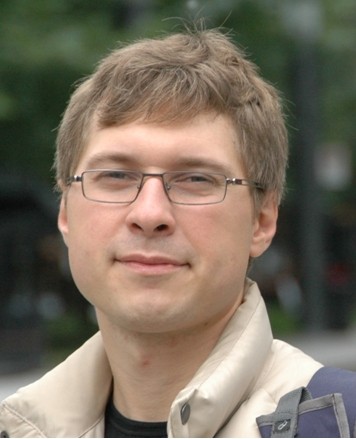Bio
Dr. Sergii Skakun is an Associate Professor with a joint appointment at the Department of Geographical Sciences and the College of Information Studies (iSchool). He joined UMD in October 2015. From 2013 to 2015, he was a Senior Engineer at Samsung SDI (South Korea), where he was responsible for developing industrial vision inspection systems. From 2006 to 2013, he has held multiple positions (latest Senior Scientist) at the Space Research Institute (Ukraine), where he was performing research in remote sensing. He received PhD in Computer Science from National Academy of Sciences of Ukraine in 2005.
Dr. Skakun has participated as a PI or Co-I in projects funded by NASA, NSF, Google, European Commission (EC), EC Joint Research Center (JRC), U.S. Civilian Research & Development Foundation (CRDF), National Academy of Sciences of Ukraine, State Space Agency of Ukraine and Science & Technology Center in Ukraine (STCU).
He is a two-time recipient as a PI of the Future Investigators in NASA Earth and Space Science and Technology (FINESST) grants "Agriculture Velocity of Winter Wheat" (2022-2025, Leonid Shumilo) and "Climate induced agriculture change hotspots and its implication to global food security in the former Soviet Union (Russia and Ukraine)" (2021-2024, Abdul Qadir).
His recent projects include "Artillery Craters and Unexploded Ordnance Mapping in Ukraine using High Resolution Satellite Imagery" (NASA, 2023-2024), "High-Impact Hot Spots of Land Cover Land Use Change: Ukraine and Neighboring Countries" (NASA, 2021-2023), "FAI: Advancing Deep Learning Towards Spatial Fairness" (NSF, 2022-2025) and "Maintenance and refinement of the Suomi NPP and NOAA-20 VIIRS Land Surface Reflectance product suite" (NASA, 2021-2024). He is currently a Co-I on two NASA Agricultural Programs: Harvest and Acres.
Within Committee on Earth Observation Satellites (CEOS), he is co-leading a Cloud Masking Inter-comparison Exercise (CMIX, https://calvalportal.ceos.org/cmix). He is currently an Associate Editor for the journal Remote Sensing of Environment. As of now, he authored or co-authored >70 papers in peer-reviewed journals, 3 books (in Ukrainian/Russian), and 6 chapters in edited books.
His current research focus is to advance methods, models and emerging technologies in the area of data science for heterogeneous remote sensing data fusion, processing and analysis, and their applications to Earth System Science and areas of societal benefit.
Recent papers:
- Shumilo, L., Skakun, S., Gore, M. L., Shelestov, A., Kussul, N., Hurtt, G., Karabchuk, D., Yarotskiy, V. (2023). Conservation policies and management in the Ukrainian Emerald Network have maintained reforestation rate despite the war. Communications Earth & Environment, 4, art. num. 443. https://doi.org/10.1038/s43247-023-01099-4
- Abys, C., Skakun, S., & Becker-Reshef, I. (2024). Two decades of winter wheat expansion and intensification in Russia. Remote Sensing Applications: Society and Environment, 33, art. num. 101097. https://doi.org/10.1016/j.rsase.2023.101097https://doi.org/10.1016/j.rsase.2023.101097
- Qadir, A., Skakun, S., Eun, J., Prashnani, M., Shumilo, L. (2023). Sentinel-1 time series data for sunflower (Helianthus annuus) phenology monitoring. Remote Sensing of Environment, 295, art. num. 113689. https://doi.org/10.1016/j.rse.2023.113689
- Duncan, E. C., Skakun, S., Kariryaa, A., & Prishchepov, A. V. (2023). Detection and mapping of artillery craters with very high spatial resolution satellite imagery and deep learning. Science of Remote Sensing, 7, art. num. 100092. https://doi.org/10.1016/j.srs.2023.100092
- Doxani, G., Vermote, E. F., Roger, J. C., Skakun, S., Gascon, F., Collison, A., ... & Yin, F. (2023). Atmospheric Correction Inter-comparison eXercise, ACIX-II Land: An assessment of atmospheric correction processors for Landsat 8 and Sentinel-2 over land. Remote Sensing of Environment, 285, art. num. 113412. https://doi.org/10.1016/j.rse.2022.113412
- Skakun, S., Wevers, J., Brockmann, C., Doxani, G., Aleksandrov, M., Batič, M., Frantz, D., Gascon, F., Gómez-Chova, L., Hagolle, O., López-Puigdollers, D., Louis, J., Lubej, M., Mateo-García, G., Osman, J., Peressutti, D., Pflug, B., Puc, J., Richter, R., Roger, J.-C., Scaramuzza, P., Vermote, E., Vesel, N., Zupanc, A., Žust, L. (2022). Cloud Mask Intercomparison eXercise (CMIX): An evaluation of cloud masking algorithms for Landsat 8 and Sentinel-2. Remote Sensing of Environment, 274, art. num. 112990. https://doi.org/10.1016/j.rse.2022.112990
- Zhang, Y., Skakun, S., Adegbenro, M.O., & Ying, Q. (2022). Leveraging the use of labeled benchmark datasets for urban area change mapping and area estimation: a case study of the Washington DC–Baltimore region. International Journal of Digital Earth, 15(1), 1169-1186. https://doi.org/10.1080/17538947.2022.2094001
- Abys, C., Skakun, S., & Becker-Reshef, I. (2022). The Rise and Volatility of Russian Winter Wheat Production. Environmental Research Communications, 4(10), art. num. 101003. https://doi.org/10.1088/2515-7620/ac97d2
- Eun, J., & Skakun, S. (2022). Characterizing land use with night-time imagery: the war in Eastern Ukraine (2012–2016). Environmental Research Letters, 17, art. num. 095006. https://doi.org/10.1088/1748-9326/ac8b23
He is teaching the following courses:
- GEOG156 / INST156 “How NASA Sees the Earth” (GenEd course),
- GEOG371 “Programming for Image Analysis”,
- GEOG272/GEOG372 "Remote Sensing".
As part of the NASA Harvest team, results of his research on the impact of the war in Ukraine on agriculture was featured in the mass media:


